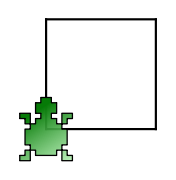Around 10 years after I finished the university functional programming course, I had a casual chat with my friend, Felix. As any two geeks, we would rarely see each other, but we had, for years, an ongoing conversation on instant messaging discussing all kinds of nerdy topics and, of course, programming.
Somehow, the topic of functional programming came up. Felix pointed out that one of my favorite and most enjoyable programming languages, LOGO, was, in fact, a functional programming language.
LOGO is an educational programming language whose main characteristic is utilization of so-called turtle graphics.
It was obvious in retrospect; here is how to write a function that draws a square in the KTurtle version of LOGO:
learn square {
repeat 4 {forward 50 turnright 90}
}
The result is shown in the following screenshot:

Can you...


